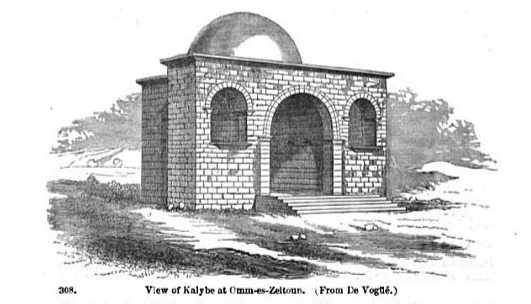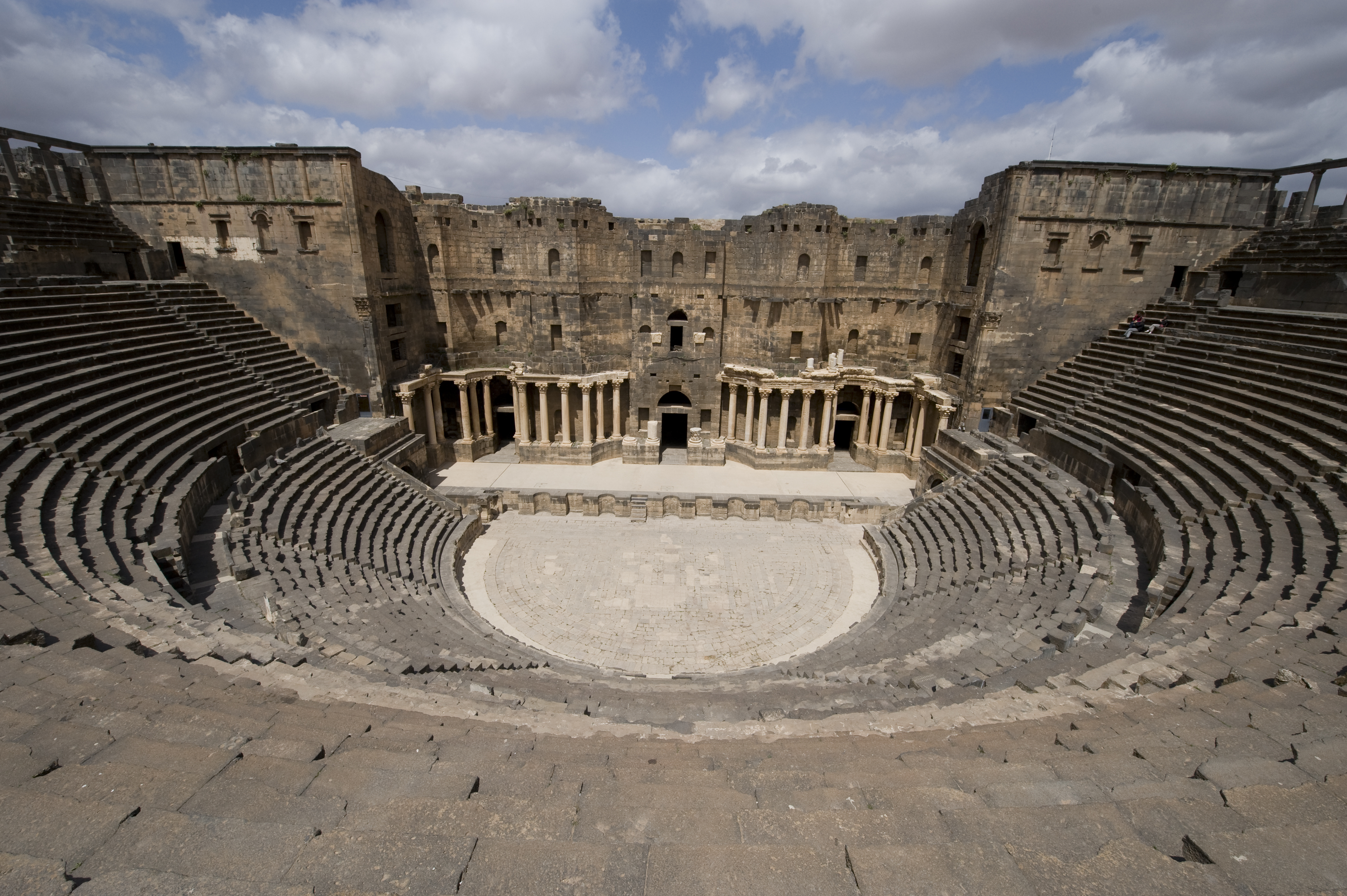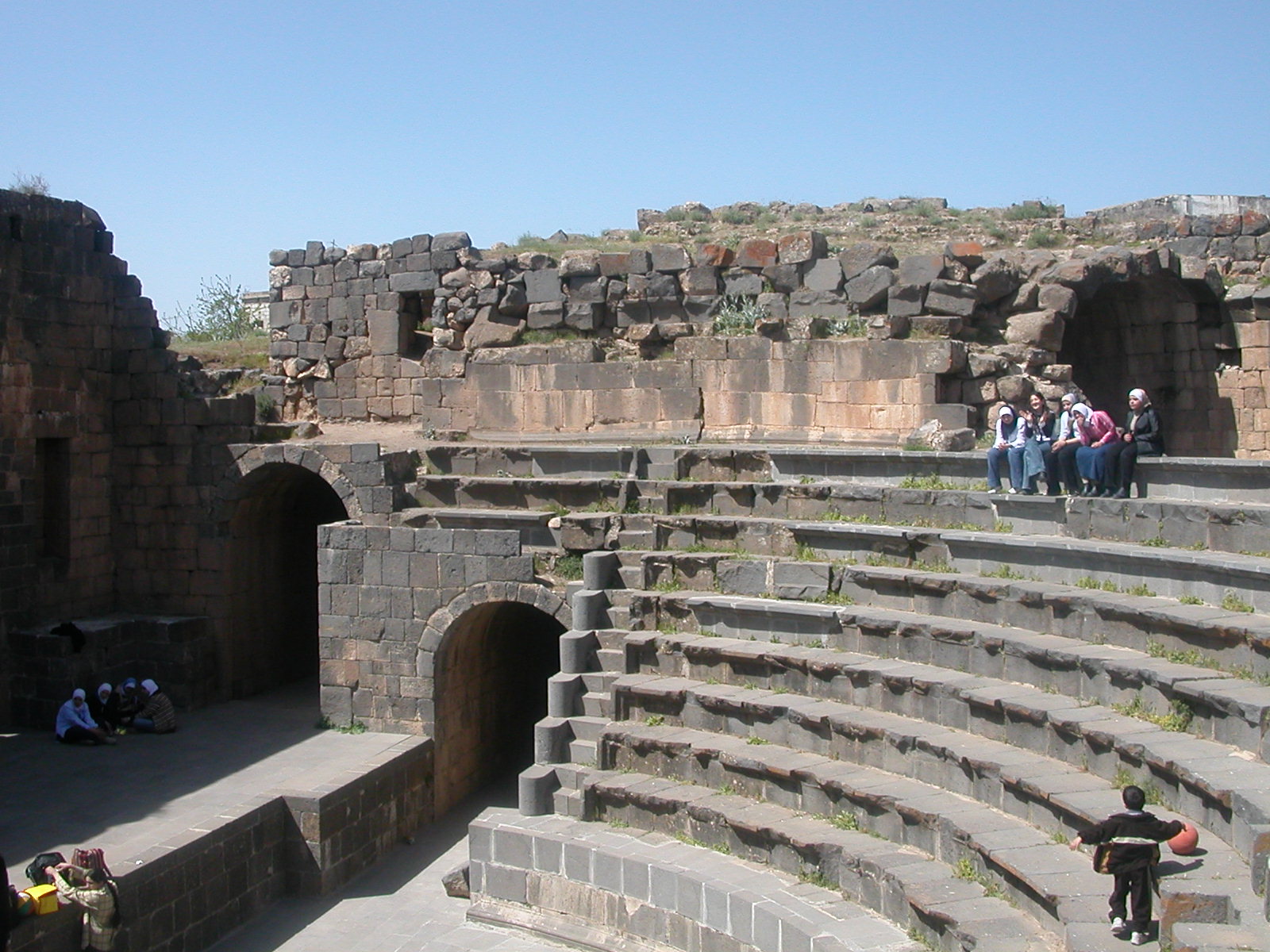|
Kalybe (temple)
A kalybe (κάλὑβη) القليب is a type of temple found in the Roman East dating from the first century and after. They were intended to serve as a "public facade or stage-setting, solely for the display of statuary." " ey were essentially stage-sets for ritual enacted ''in front'' of them." The kalybe has been associated with the Roman imperial cult. The first kalybe to be identified as a distinct type was in Umm Iz-Zetun (or Zetum),For one modern spelling of the toponym. described by Eugène-Melchior de Vogüé in 1867. Together with the temple he found two Greek inscriptions describing the structure as a "kalybe." Other than these, the only occurrence of the term is in a lexicon of Hesychius of Alexandria from the fifth century, Since that time more than seven similar temples have been identified in Roman Syria. In addition to Umm Iz-Zetum these include Shaqqa (''Saccaea''), Il-Haiyat, Shahba (''Philippopolis'') (built around 245 by the Emperor Philip the Arab), Qan ... [...More Info...] [...Related Items...] OR: [Wikipedia] [Google] [Baidu] |
Kalybe Umm Iz Zetum
Calybe (Ancient Greek: Καλυβη means "rustic hut") may refer to the two distinct characters from Greek mythology: * Calybe, a nymph who was a wife of the Troy, Trojan king Laomedon and the mother of Bucolion. * Calybe, one of the follower of Dionysus in the India, Indian War.Nonnus, 29.270 Notes References * Bibliotheca (Pseudo-Apollodorus), (Pseudo-)Apollodorus, ''The Library'', with an English translation by Sir James George Frazer (1921). 2 volumes. Cambridge, MA: Harvard University Press; London: William Heinemann Ltd. . *English translationavailable at the Perseus Digital Library. *Greek textavailable from the same website. * *English translationavailable at the Topos Text Project. *Greek text available at the Perseus Digital Library. {{Greek myth index Nymphs Maenads Companions of Dionysus ... [...More Info...] [...Related Items...] OR: [Wikipedia] [Google] [Baidu] |
Qanawat
Qanawat ( ar, قَنَوَات, Qanawāt) is a village in Syria, located 7 km north-east of al-Suwayda. It stands at an elevation of about 1,200 m, near a river and surrounded by woods. Its inhabitants are entirely from the Druze community. According to the Syria Central Bureau of Statistics (CBS), Qanawat had a population of 8,324 in the 2004 census. History Qanawat is one of the earliest cities in the Bashan and Hauran areas. It is probably evidenced in the Hebrew Bible as Kenath (Hebrew: קְנָת, , ). Possible earlier evidence, is from Ancient Egyptian documents like the execration texts (second group) of the 20th-19th century BC, and the Amarna letters of the 14th century BC (as Qanu, in EA 204). Hellenistic and Roman history The ancient Hellenistic-Roman city of Canatha (also Kanatha, Κάναθα in Ancient Greek), is mentioned for the first time in the reign of Herod the Great (1st century BC), when Nabatean Arab forces defeated a Jewish army. It remain ... [...More Info...] [...Related Items...] OR: [Wikipedia] [Google] [Baidu] |
Ancient Roman Buildings And Structures
Ancient history is a time period from the beginning of writing and recorded human history to as far as late antiquity. The span of recorded history is roughly 5,000 years, beginning with the Sumerian cuneiform script. Ancient history covers all continents inhabited by humans in the period 3000 BCAD 500. The three-age system periodizes ancient history into the Stone Age, the Bronze Age, and the Iron Age, with recorded history generally considered to begin with the Bronze Age. The start and end of the three ages varies between world regions. In many regions the Bronze Age is generally considered to begin a few centuries prior to 3000 BC, while the end of the Iron Age varies from the early first millennium BC in some regions to the late first millennium AD in others. During the time period of ancient history, the world population was already exponentially increasing due to the Neolithic Revolution, which was in full progress. While in 10,000 BC, the world population stood at ... [...More Info...] [...Related Items...] OR: [Wikipedia] [Google] [Baidu] |
Petra
Petra ( ar, ٱلْبَتْرَاء, Al-Batrāʾ; grc, Πέτρα, "Rock", Nabataean Aramaic, Nabataean: ), originally known to its inhabitants as Raqmu or Raqēmō, is an historic and archaeological city in southern Jordan. It is adjacent to the mountain of Jebel al-Madhbah, Jabal Al-Madbah, in a Depression (geology), basin surrounded by mountains forming the eastern flank of the Arabah valley running from the Dead Sea to the Gulf of Aqaba. The area around Petra has been inhabited from as early as 7000 BC, and the Nabataeans might have settled in what would become the capital city of Nabataean Kingdom, their kingdom as early as the 4th century BC. Archaeological work has only discovered evidence of Nabataean presence dating back to the second century BC, by which time Petra had become their capital. The Nabataeans were nomadic Arabs who invested in Petra's proximity to the incense trade routes by establishing it as a major regional trading hub. The trading business gained ... [...More Info...] [...Related Items...] OR: [Wikipedia] [Google] [Baidu] |
Rabbel II Soter
Rabbel II Soter (Nabataean Aramaic: ''Rabʾel dī ʾaḥyēy wa-šēzīb ʿammeh'', "Rabbel, who gave life and deliverance to his people") was the last ruler of the Nabataean Kingdom, ruling from 70 to 106. After the death of his father, Malichus II, Rabbel still a child, ascended to the throne. His mother, Shaqilath II, assumed the regency of the Nabataean Kingdom, during the minority of her son Rabel II in 70-76 AD. His sister Gamilath became queen of the Nabataeans. Rabbel gave himself the Greek title "Soter",Taylor (2001), pp.73-74 meaning "Savior". He reigned with his first wife Queen Gamilath and his second wife Queen Hagaru. Gamilat was a queen in 76–102 CE and Hagru was a queen in 102–106. After his death in 106, the Roman emperor Trajan faced practically no resistance and conquered the kingdom on 22 March 106. It became the Roman province of Arabia Petraea, with Bosra becoming its provincial capital. See also * List of rulers of Nabatea The Rulers of Nabataea, ... [...More Info...] [...Related Items...] OR: [Wikipedia] [Google] [Baidu] |
Nabataean
The Nabataeans or Nabateans (; Nabataean Aramaic: , , vocalized as ; Arabic: , , singular , ; compare grc, Ναβαταῖος, translit=Nabataîos; la, Nabataeus) were an ancient Arab people who inhabited northern Arabia and the southern Levant. Their settlements—most prominently the assumed capital city of Raqmu (present-day Petra, Jordan)—gave the name ''Nabatene'' ( grc, Ναβατηνή, translit=Nabatēnḗ) to the Arabian borderland that stretched from the Euphrates to the Red Sea. The Nabateans emerged as a distinct civilization and political entity between the 4th and 2nd centuries BCE,Taylor, Jane (2001). ''Petra and the Lost Kingdom of the Nabataeans''. London: I.B.Tauris. pp. 14, 17, 30, 31. . Retrieved 8 July 2016. with their kingdom centered around a loosely controlled trading network that brought considerable wealth and influence across the ancient world. Described as fiercely independent by contemporary Greco-Roman accounts, the Nabataeans were annexed ... [...More Info...] [...Related Items...] OR: [Wikipedia] [Google] [Baidu] |
Hippos, Israel
Hippos ( grc, Ἵππος, , horse) or Sussita (Aramaic, he, סוסיתא) is an ancient city and archaeological site in the former Israel-Syria DMZ, located on a hill on the slopes of the Golan Heights overlooking the Sea of Galilee. Hippos was a Hellenistic city in the northern Jordan Valley, and a long-time member of the Decapolis, a group of ten cities more closely tied to the Greco-Roman culture than to the local Semitic-speaking population. Later, Hippos became a predominantly Christian city, which declined towards the end of the Byzantine period and throughout the Early Muslim period, and was abandoned after the 749 earthquake. Today, the ruins of Hippos are open to visitors of the Susita (Hippos) Nature Reserve and National Park. Location Hippos was built on a flat-topped foothill east of and above the Sea of Galilee, above sea level, near modern Kibbutz Ein Gev. Besides the fortified city itself, Hippos controlled two harbor facilities on the Sea of Galilee a ... [...More Info...] [...Related Items...] OR: [Wikipedia] [Google] [Baidu] |
Amman
Amman (; ar, عَمَّان, ' ; Ammonite language, Ammonite: 𐤓𐤁𐤕 𐤏𐤌𐤍 ''Rabat ʻAmān'') is the capital and largest city of Jordan, and the country's economic, political, and cultural center. With a population of 4,061,150 as of 2021, Amman is Jordan's primate city and is the List of largest cities in the Levant region by population, largest city in the Levant region, the list of largest cities in the Arab world, fifth-largest city in the Arab world, and the list of largest metropolitan areas of the Middle East, ninth largest metropolitan area in the Middle East. The earliest evidence of settlement in Amman dates to the 8th millennium BC, in a Neolithic site known as ʿAin Ghazal, 'Ain Ghazal, where the world's ʿAin Ghazal statues, oldest statues of the human form have been unearthed. During the Iron Age, the city was known as Rabat Aman and served as the capital of the Ammon, Ammonite Kingdom. In the 3rd century BC, Ptolemy II Philadelphus, Pharaoh of Ptole ... [...More Info...] [...Related Items...] OR: [Wikipedia] [Google] [Baidu] |
Bosra
Bosra ( ar, بُصْرَىٰ, Buṣrā), also spelled Bostra, Busrana, Bozrah, Bozra and officially called Busra al-Sham ( ar, بُصْرَىٰ ٱلشَّام, Buṣrā al-Shām), is a town in southern Syria, administratively belonging to the Daraa District of the Daraa Governorate and geographically part of the Hauran region. According to the Syria Central Bureau of Statistics (CBS), Bosra had a population of 19,683 in the 2004 census. It is the administrative center of the ''nahiyah'' ("subdistrict") of Bosra which consisted of nine localities with a collective population of 33,839 in 2004. Bosra has an ancient history and during the Roman era it was a prosperous provincial capital and Metropolitan Archbishopric, under the jurisdiction of Eastern Orthodox Patriarchate of Antioch and All the East. It continued to be administratively important during the Islamic era, but became gradually less prominent during the Ottoman era. It also became a Latin Catholic titular see and the ... [...More Info...] [...Related Items...] OR: [Wikipedia] [Google] [Baidu] |
Philip The Arab
Philip the Arab ( la, Marcus Julius Philippus "Arabs"; 204 – September 249) was Roman emperor from 244 to 249. He was born in Aurantis, Arabia, in a city situated in modern-day Syria. After the death of Gordian III in February 244, Philip, who had been Praetorian prefect, achieved power. He quickly negotiated peace with the Persian Sassanid Empire and returned to Rome to be confirmed by the Senate. During his reign, the city of Rome celebrated its millennium. Philip was betrayed and killed at the Battle of Verona in September 249 following a rebellion led by his successor, Gaius Messius Quintus Decius. Philip's reign of five years was uncommonly stable in a turbulent third century. During the late 3rd century and into the 4th, it was held by some churchmen that Philip had been the first Christian emperor; he was described as such in Jerome's ''Chronicon'' (''Chronicle''), which was well known during the Middle Ages, in Orosius' highly popular ''Historia Adversus Paganos ... [...More Info...] [...Related Items...] OR: [Wikipedia] [Google] [Baidu] |
Temple
A temple (from the Latin ) is a building reserved for spiritual rituals and activities such as prayer and sacrifice. Religions which erect temples include Christianity (whose temples are typically called churches), Hinduism (whose temples are called Mandir), Buddhism, Sikhism (whose temples are called gurudwara), Jainism (whose temples are sometimes called derasar), Islam (whose temples are called mosques), Judaism (whose temples are called synagogues), Zoroastrianism (whose temples are sometimes called Agiary), the Baha'i Faith (which are often simply referred to as Baha'i House of Worship), Taoism (which are sometimes called Daoguan), Shinto (which are sometimes called Jinja), Confucianism (which are sometimes called the Temple of Confucius), and ancient religions such as the Ancient Egyptian religion and the Ancient Greek religion. The form and function of temples are thus very variable, though they are often considered by believers to be, in some sense, the "house" of ... [...More Info...] [...Related Items...] OR: [Wikipedia] [Google] [Baidu] |
Shahba
Shahba ( ar, شَهْبَا / ALA-LC: ''Shahbā'') is a city located south of Damascus in the Jabal el Druze in As-Suwayda Governorate of Syria, but formerly in the Roman province of Arabia Petraea. Known in Late Antiquity as Philippopolis (in Arabia), the city was the seat of a Bishopric (see below), which remains a Latin titular see. History Roman history The oasis settlement now named Shahba had been the native hamlet of the Roman emperor Philip the Arab. After Philip became emperor in 244 CE, he dedicated himself to rebuilding the little community as a '' colonia''. The contemporary community that was replaced with the new construction was so insignificant that one author states that the city can be considered to have been built on virgin soil, making it the last of the Roman cities founded in the East. The city was renamed Philippopolis (a name with homonyms) in dedication to the emperor, who is said to have wanted to turn his native city into a replica of Rome hers ... [...More Info...] [...Related Items...] OR: [Wikipedia] [Google] [Baidu] |








